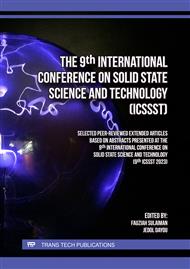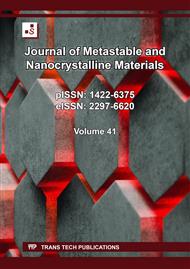[1]
Eskandari M, Shanaghi A, Kamani M, Niari MA. Effect of nano-metal oxides (ZnO, Al2O3, CuO, and TiO2) on the corrosion behavior of a nano-metal oxide/epoxy coating applied on the copper substrate in the acidic environment. Applied Nanoscience 2021, 11:1605-15.
DOI: 10.1007/s13204-021-01806-7
Google Scholar
[2]
Aghili M, Yazdi MK, Ranjbar Z, Jafari SH. Anticorrosion performance of electro-deposited epoxy/ amine functionalized graphene oxide nanocomposite coatings. Corrosion Science 2021, 179:109143.
DOI: 10.1016/j.corsci.2020.109143
Google Scholar
[3]
Mohammadzadeh A, Ghafouri Taleghani H, Lashkenari MS. Preparation and comparative study of anticorrosion nanocomposites of polyaniline/graphene oxide/clay coating. Journal of Materials Research and Technology 2021, 13:2325-35.
DOI: 10.1016/j.jmrt.2021.05.098
Google Scholar
[4]
Ghodki BM, Patel A, Choudhary P, Kalnar YB, Narsaiah K. TiO2-epoxy nanocomposites coated steel: Surface morphology, spectroscopic, and photocatalytic characteristics. Surface and Interface Analysis 2023, 55:347-56.
DOI: 10.1002/sia.7197
Google Scholar
[5]
Pourhashem S, Saba F, Duan J, Rashidi A, Guan F, Nezhad EG, Hou B. Polymer/Inorganic nanocomposite coatings with superior corrosion protection performance: A review. Journal of Industrial and Engineering Chemistry 2020, 88:29-57.
DOI: 10.1016/j.jiec.2020.04.029
Google Scholar
[6]
Yaman K, Taga O. Thermal and electrical conductivity of unsaturated polyester resin filled with copper filler composites. International Journal of Polymer Science 2018, 2018:8190190.
DOI: 10.1155/2018/8190190
Google Scholar
[7]
Yaman K. Fractal characterization of electrical conductivity and mechanical properties of copper particulate polyester matrix composites using image processing. Polymer Bulletin 2022, 79: 3309–3332.
DOI: 10.1007/s00289-021-03665-2
Google Scholar
[8]
Said A, Yacine O, Omar M. Development and characterisation of metal matrix composite steel/Cu-Zn. Asian Journal of Materials Science 2009,1:7.
Google Scholar
[9]
Muresan LM. Nanocomposite coatings for anti-corrosion properties of metallic substrates. Materials, 2023.
Google Scholar
[10]
Baghani M, Aliofkhazraei M, Askari M: Cu−Zn−Al2O3 nanocomposites: study of microstructure, corrosion, and wear properties. International Journal of Minerals, Metallurgy, and Materials 2017, 24:462-72.
DOI: 10.1007/s12613-017-1427-0
Google Scholar
[11]
Abdoos H, Memar S, Riahi MR. An examination of microstructure, mechanical and dry wear properties of stir cast brass/Al2O3 composites. Canadian Metallurgical Quarterly 2021, 60:97-110.
DOI: 10.1080/00084433.2021.1968256
Google Scholar
[12]
Zhang J, Li Y, Bao F, Rui X, Duan Z, Yan W, Shi Q, Wang W, Shan Y, Yang K. Study on the formation mechanism of Y-Ti-O oxides during mechanical milling and annealing treatment. Advanced Powder Technology 2021, 32:582-90.
DOI: 10.1016/j.apt.2021.01.005
Google Scholar
[13]
Yuan L, Wang C, Cai R, Wang Y, Zhou G. Spontaneous ZnO nanowire formation during oxidation of Cu-Zn alloy. Journal of Applied Physics 2013, 114.
DOI: 10.1063/1.4812569
Google Scholar
[14]
Pola A, Tocci M, Goodwin FE. Review of microstructures and properties of zinc Alloys. Metals 2020, 10 (2): 253.
DOI: 10.3390/met10020253
Google Scholar
[15]
Eva Maria PS, Cristina MAM, Isabel MM. In situ titanium composites: XRD study of secondary phases Tied to the Processing Conditions and Starting Materials. Inelastic X-Ray Scattering and X-Ray Powder Diffraction Applications. Edited by Alessandro C, Margareth KKDF, Fabiano Y. Rijeka: IntechOpen, 2019.
DOI: 10.5772/intechopen.88625
Google Scholar
[16]
Ramesh M, Rajeshkumar LN, Srinivasan N, Kumar DV, Balaji D. Influence of filler material on properties of fiber-reinforced polymer composites: A review. e-Polymers 2022, 22:898-916.
DOI: 10.1515/epoly-2022-0080
Google Scholar
[17]
Huang Y, Huang J, Zhang J, Yu X, Li Q, Wang Z, Fan D. Microstructure and corrosion characterization of weld metal in stainless steel and low carbon steel joint under different heat input. Materials Today Communications 2021, 29:102948.
DOI: 10.1016/j.mtcomm.2021.102948
Google Scholar



